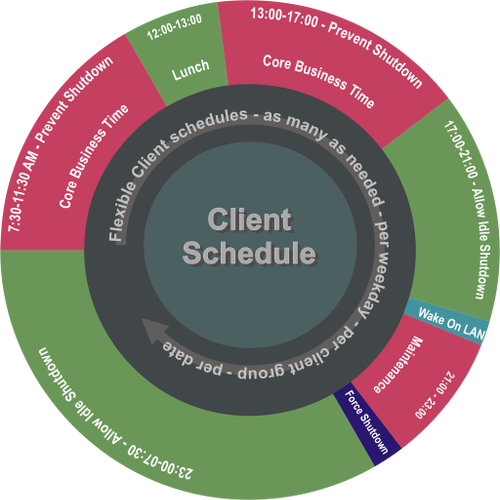Auto Shutdown Manager operates even if no users are logged on in a so-called full background or service mode. All operations are supported in this mode, including power up, power down, restart, standby, updates and patches, deployment and receiving of new settings, and the execution of time rules.
Flexible Operation Modes
The operation modes provided by Auto Shutdown Manager are highly flexible.
Depending on the required policies, the system can be configured in a "Can", "Should" or "Must" shutdown mode. Shutdowns can be prevented during core business times or while maintenance tasks are being performed.
Outside of business hours, the idle shutdown timer will start monitoring the PC for productive tasks and active users. If no one can be detected for a specified period, open documents will be saved and the PCs shut down in a default or specified mode such as standby, hibernation, or power off. The default shutdown mode can be specified depending on the time, day of week or date.

This is an example what a day could look like:
RED: The PC will not shut down
GREEN: The PC may shut down (for example, Standby), if detected as idle (not productive)
Light Blue: The server starts the PC for maintenance via WoL
Dark Blue: The PC will shut down
All Systems can be grouped by required policies:
"CAN" - allow shutdown, but respect users
One group of PCs could be configured to be allowed to go into a defined sleep mode
during lunch hours. This means that, if no activities are detected during a defined
period, the systems would be allowed to go into a defined sleep mode such
as Standby.
Thus, the logical rule for lunchtime could be:
- Keep running continuously between 7:30 am and 11:45 am (core business time)
- Check for user or system activities between 11:45 am and 1:15 pm - if there are no activities for at least 10 minutes - go into Standby...
- Wake up at 1:15 pm (if wanted at all)
- Keep permanent running between 1:15am until 5:00 pm (core business time)
- Check for user or system activities after 5 pm - if there are no activities for at least 10
minutes - go into Hibernation...
"SHOULD" - try to shut down at a specified time, but with a warning message and user decision
Another group of PCs could be set up to go into sleep mode during lunch hours, for example at 12:15 pm, regardless of other options. In this case, the users would receive a warning message notifying them about the planned shutdown. If the users want to continue their work, they just simply disagree and continue their work.
Finally, the idle shutdown timer would shut down the PCs when the users forget to do so after their work is done. Of course, unsaved documents would be saved automatically before the shutdown.
“MUST”- enforce shut down without user interaction
Another group of PCs could be used to display stock prices, for example. This only makes sense until the market closes, plus some extra time for aftermarket deals. Therefore, these PCs could definitely be switched off at 6 pm every day. In this case, the shutdown could be enforced without any user interaction.
Auto Shutdown Manager operates with network awareness
In enterprise environments, as well as in an increasing number of networked homes, - it is essential for the systems to run reliably and to be available during core business hours or whenever needed. Furthermore, systems might depend on each other. For example, clients’ computers cannot be operated properly if their servers are not available. To map these requirements, Auto Shutdown Manager was built with network-aware logic. This means that clients’ computers can wake their servers on demand and keep then running for as long as required. On the other hand, the servers know about the clients and keep up and running until the last client disconnects. In addition, other IP-enabled equipment can be used to control the idle shutdown decision.
See the manual for more details, or get your free 45-day evaluation copy now.

 DE
DE  EN
EN